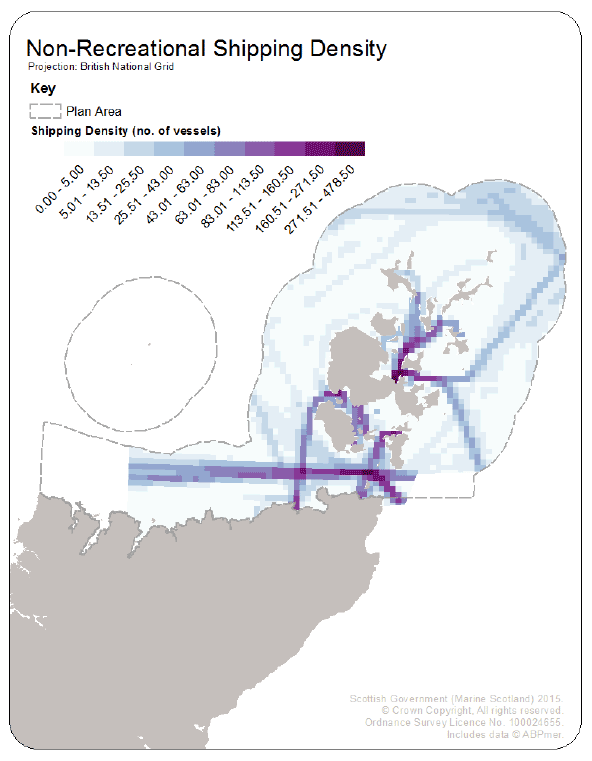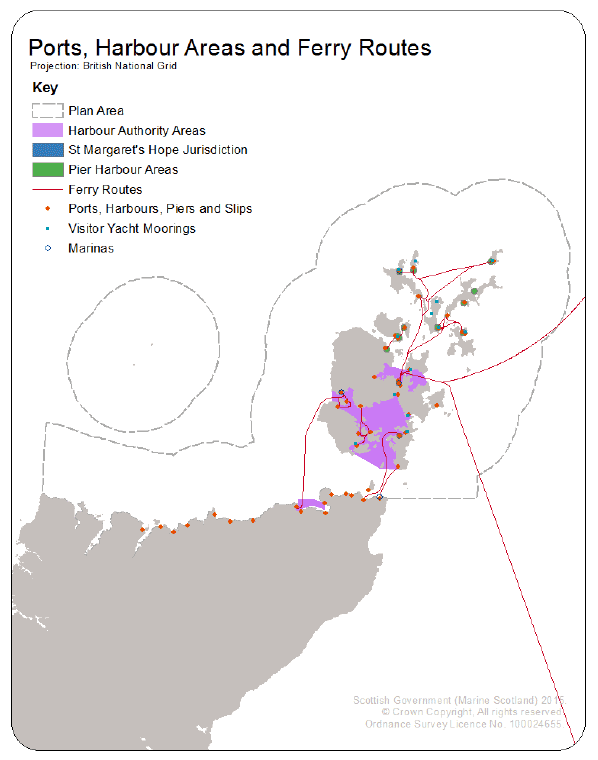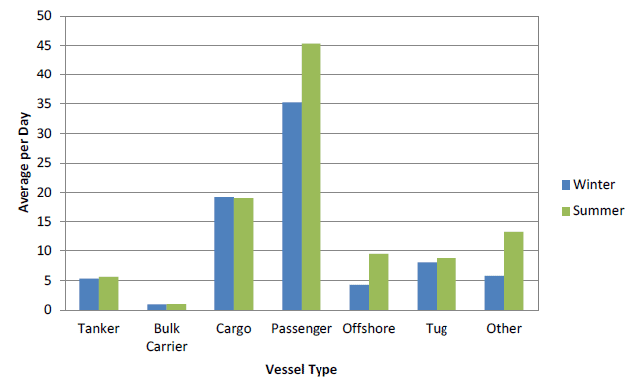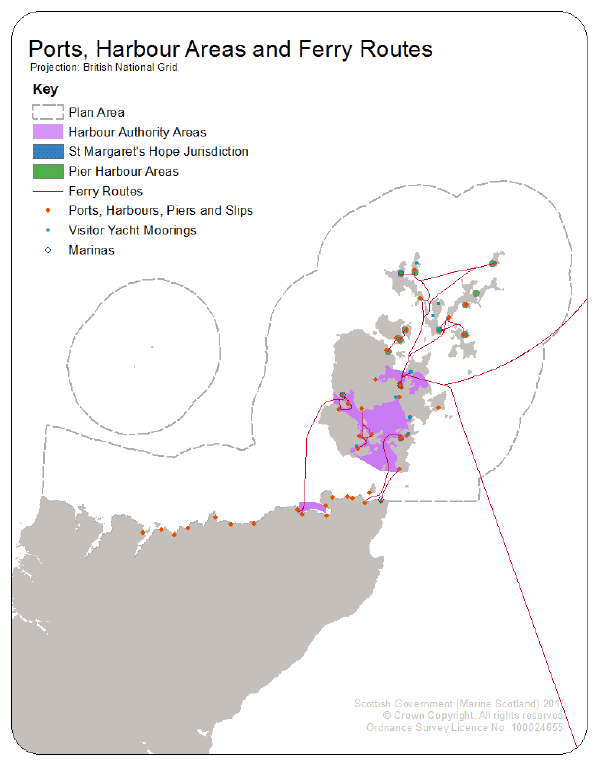Pilot Pentland Firth and Orkney Waters Marine Spatial Plan - Socio-Economic Baseline Review
This Socio-Economic Baseline Review provides a regional overview of the Pentland Firth and Orkney Waters area for the pilot Pentland Firth and Orkney Waters Marine Spatial Plan. It also informs the Sustainability Appraisal for this Plan.
13 Marine Transport, Ports and Harbours
13.1 Spatial Extent and Intensity of Activity and Interests
13.1.1 The Pentland Firth is recognised as a route of international importance for navigation and is considered to be crucial for shipping and navigation, despite being one of the most dangerous and unpredictable stretches of water in the UK due to it being prone to strong tides, heavy seas and poor weather conditions.
13.1.2 The Marine Scotland Shipping Study of the Pentland Firth and Orkney Waters [50] gives an overview of the shipping activity in the PFOW. Figure 14 shows the intensity of shipping activity. There is a clear band of shipping activity transiting the PFOW in an East-West / West-East bearing. The intensity is greatest where there is an overlap between transiting ships and the passenger services connecting Orkney Mainland to the Scottish mainland. Figure 15 shows ferry routes in the PFOW area.
Figure 14 Shipping density in PFOW area [51]

Figure 15 Ferry routes in the PFOW Area [52]

13.1.3 The area is used extensively by commercial cargo vessels as the main route from the North Atlantic to the North Sea. It is also used by oil tankers entering and exiting the main oil terminals at Flotta at the southern end of Scapa Flow. This combination of cargo traffic and oil tankers leads to very high numbers of vessel movements occurring within the main central channel. Very high densities of shipping also occur within Orkney waters, in particular within the Scapa Flow area, the Stronsay Firth and around Kirkwall Harbour. [53]
13.1.4 A 'Shipping Study of the Pentland Firth and Orkney Waters' [54] was commissioned by Marine Scotland, published in 2012. The study gave a detailed description of the shipping activity in the PFOW, covering commercial shipping, recreation vessel activity, ports & harbours and other recreational activity. The report concluded:
- Distribution of vessel types is similar in winter and summer, with passenger vessels being the most common type, followed by cargo vessels (Figure 16 below shows results from the Automatic Identification System ( AIS)). There were a slightly higher average number of vessels per day during the summer period for the vessel categories of passenger, offshore and other. Commercial shipping in the Strategic Area tended to follow well defined tracks for the different vessel types.
Figure 16 Vessel Length Distribution by Season [54]

- The most common category of vessel draught was 4-6m. There were a higher proportion of deep draught vessels in summer compared to winter, due to an increase in the number of large cargo ships. As with length, the deepest draught vessels tended to be transiting the Outer Sound of the Pentland Firth or the Fair Isle Channel.
- The pattern of vessel tonnage is similar to that observed in length and draught analysis. The most common category was 300-1,500 GT, with regular runners in this category including the Pentalina passenger ferry and Orkney Islands inter-island ferries. The heaviest vessels transited the Outer Sound and the Fair Isle Channel. Vessels over 15,000 GT tracked within the Orkney Islands were passenger cruise vessels and tankers associated with Flotta Marine Terminal.
- Tankers tracked within the Strategic Area were mainly transiting through the Outer Sound or through the Fair Isle Channel to a variety of destinations. Over the timescale of the project six tankers were tracked at harbours within the Strategic Area (Scrabster, Kirkwall, Flotta Marine Terminal and Scapa Bay).
- The most common destinations of vessels tracked within the PFOW area were Kirkwall, Scrabster and Stromness. Lerwick and Aberdeen were the most common destinations beyond the area.
13.1.5 There are a number of ferry services connecting Orkney to mainland Scotland, as well as inter-island ferries. NorthLink Ferries connect Orkney with mainland Scotland and Shetland, sailing from Scrabster to Stromness, and Aberdeen to Kirkwall and onwards to Lerwick, Shetland. As well as transporting passengers, Northlink provides transport of commercial goods and freight. A summary of the NorthLink Ferries carrying statistics is shown in Table 25.
Table 25 NorthLink Ferries carrying statistics (NorthLink Ferries, 2013) [55]
| Route | Total Passengers 2013 | Total Cars 2013 | Total Coaches 2013 | Total Commercial Vehicle Lane Meterage 2013 |
|---|---|---|---|---|
| Aberdeen - Kirkwall | 34,179 | 4,794 | 16 | 131,765 |
| Aberdeen - Lerwick | 116,800 | 16,889 | 126 | 304,119 |
| Kirkwall - Lerwick | 16,269 | 2,242 | 64 | 15,789 |
| Stromness - Scrabster | 115,616 | 31,733 | 197 | 52,261 |
| Summary | 282,864 | 55,658 | 403 | 503,934 |
13.1.6 Orkney Ferries operate 9 inter-island ferries between Orkney Mainland and 13 Orkney islands. The Orkney Ferries fleet transports over 82,000 vehicles, undertaking around 320,000 passenger journeys annually [56] . Pentland Ferries - a private enterprise not subsidised by the Scottish Government - offer the shortest passenger and car ferry service, from Gills Bay to St Margaret's Hope. There is also a May-September service between John O'Groats and Burwick (South Ronaldsay), which is the shortest passenger-only service. [57]
13.1.7 The location of all of the ports and harbours in the PFOW can be found on the ports and harbours of the UK website [58] . There are 18 harbours along the north Caithness Coast (Figure 17). Scrabster is the main harbour on the North Coast- this is an active fishing port and is the main port for sea angling. Scrabster has recently undergone a number of improvements and has plans for further extensions to support the growth of the renewable energy industry.
13.1.8 There are 29 piers, harbours and slipways in Orkney. The main ports are Hatston Pier, Kirkwall Pier and Stromness. The ports receive a variety of ships including cruise ships with up to 3,500 passengers, oil tankers, cargo and freight vessels and other ships. Crude oil is imported to the Flotta Oil terminal on the north coast of Flotta, through a 30" pipeline from several offshore facilities. Transhipment by tankers also takes place. Scapa Flow itself provides a large sheltered anchorage and a number of ship-to-ship transfers take place within it.
13.2 Economic value and employment
13.2.1 The Scottish Ferries Review (2010) provides ferry services employment data for the Highlands and Islands as shown in Table 26. There are 2,169 jobs supported by Scottish Ferry services: 1,325 of these are in Highlands and Islands with an additional 774 in the rest of Scotland and 70 outside Scotland. Company level employment data for services within the PFOW area is confidential.
Table 26 Ferry operations direct employment within the Highlands and Islands [59]
| Area | Number of Jobs | Share of Jobs |
|---|---|---|
| Argyll and Bute | 423 | 32% |
| Orkney | 278 | 21% |
| Shetland | 227 | 17% |
| Outer Hebrides | 208 | 16% |
| Highland | 177 | 13% |
| Moray | 12 | 1% |
| Total | 1,325 | 100% |
13.2.2 Whilst shipping intensity levels and ferry routes provide an indication of the volume of activity, at a spatial level the economic value of marine transport passing within the PFOW area is difficult to calculate. Despite economic data being largely limited to the traffic statistics that Transport Scotland holds [60] , it is clear that this economic activity provides an important function to the secondary markets through the transport of individuals or freight.
13.2.3 Scrabster Harbour is an established commercial port and hub of economic activity which occupies a strategically important location within the Pentland Firth. The total annual economic output of Scrabster Harbour in 2008 was £39 million. The gross value added ( GVA) impact of the activities of Scrabster retained in Caithness was £14.6 million, with the total employment impact of Scrabster being 339 full time equivalent ( FTE) jobs. Harbour activities generate over £6 million in wages and salaries within Caithness [61] .
Figure 17 Location of ports and harbours in the PFOW [62]

13.2.4 Orkney's Three Port Strategy [63] is the Orkney Islands Plan for investment and development for Lyness, Hatston and Coplands Dock, Stromness in Orkney. £22 million investment from the Orkney Islands Council, European Regional Development Fund and the Scottish Government has been allocated to promote Orkney's strategic location and deep water facilities in support of existing oil and gas industries and the emerging marine renewables industry. The breakdown of this investment is shown in Table 27.
Table 27 Harbour investment in PFOW [64]
| Location | Investment (£m) |
|---|---|
| Scrabster Harbour | 20 |
| Lyness | 2.97 |
| Hatston Pier, Kirkwall | 10.1 |
| Coplands Dock | 9.5 |
| Total | 42.57 |
13.2.5 Gills Harbour is the most northerly port on the Scottish Mainland, and is where Pentland Ferries connect Orkney to the Scottish Mainland. The harbour is the closest on the Scottish mainland to the tidal developments in the Pentland Firth (Ness of Duncansby, Brims Tidal Array, Inner Sound and Brough Ness) leased by the Crown Estate. Gills Harbour has been utilised for surveys, instrument-monitoring and is currently upgrading its facilities to allow installation by work vessels for marine renewable developments in the Pentland Firth.
13.2.6 Although not directly adjacent to the PFOW area, Wick Harbour [65] provides a marina for recreational boating berths and a commercial harbour suited to the marine renewable energy industry and oil & gas. It is strategically located to provide services to oil & gas developments in the Moray Firth and West of Shetland, along with marine renewable energy developments in the Pentland Firth.
13.3 Historic and future trends
13.3.1 Shipping volumes bear a direct relationship to the global economic market. As markets react to the changing financial situation, shipping lines respond with services to move goods and people. The most notable variable to affect the volume and intensity of shipping into the future will be the technology and innovations used to design future shipping. Ship design seeks for bigger, faster and more economic transhipment of goods and people. The introduction of bigger ships places expectations that existing ports will increase the depth of water in entrance channels and alongside berths to accommodate changing ship requirements. This implies that investment is necessary in port infrastructure, both in terms of shore side facilities and access to the ports, in addition to the need for further port development and services to support the offshore renewable sector within the region as mentioned above. Channel widths may need to increase to take account of the wider ship beam, which in addition may lead to the requirement for turning circles to be enlarged to take account of greater vessel length. Although all of these pressures have to be taken into account, probably the most significant factor to challenge traditional ports in the context of their ability to accommodate bigger ships is sea access, and in particular vessel draught.
13.4 Data Gaps and Limitations
13.4.1 With the exception of GVA and employment data for ports available economic data are limited.
Contact
There is a problem
Thanks for your feedback